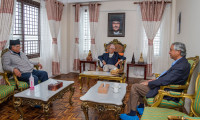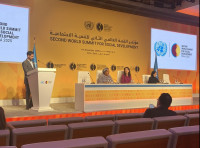Opinion
Ominous tides
Local elections, if held without bringing the Morcha on board, will be another way of entrenching Kathmandu’s power
Pramod Mishra
Nepal’s local elections are caught in the “to be or not to be” dilemma. If they go through, some believe villages in Nepal will turn into a local paradise, while others think that without the constitutional amendment to meet the Madhesi Morcha’s demands, elections will usher in a dystopia that will tear Nepal into pieces. But if the local elections don’t happen, the utopians believe that the achievements of the People’s Movement of 2006—republicanism, federalism, secularism—may disappear. So, while some see the local elections as the key to ending Nepal’s crises, others hold the view that conducting local elections could open a Pandora’s box.
Let’s take a look at Nepal’s local versus central dichotomy. Indeed, Nepalis lived and, to a great extent, still do live in the villages, where people carry on their diurnal, nocturnal, weekly, seasonal, crop cycle routines, and go to the markets and towns for official work, seasonal trade and medical purposes. The utopians are right in thinking that if the local levels get organised and either empower themselves or are empowered, Nepal can leap forward faster than it has done before. For example, Nepal’s villages could run themselves locally through representatives. Villages could be responsible for schooling, library and information centres, and agricultural know-how.
Importance could also be given to small businesses and cottage industries run by women, as more and more able-bodied men leave Nepal for the Middle East and South East Asian countries in search of better paid semi-skilled and unskilled work. Mahatma Gandhi alluded to this notion of utopia when he propounded the concept of Panchayat Raj for India. He proposed a Gram Swaraj, a system of village self-governance, which was to offer local solutions to local problems.
Panchayat days
We all know what happened when king Mahendra implemented this concept in Nepal. Formerly independent villages run by nature’s vagaries or by the whims of local ethnic zamindars were allotted a local Pradhan Panch, Upa-Pradhan Panch, ward chief and ward members. However, this system was barely different from what the villages had before, where an informal local village or community group assembled and presided over disputes. These Panchayat chiefs were almost always either former zamindars or their children. These chiefs were turned into the local level pawns of the Panchayat regime in Kathmandu. The ultimate authority rested in the monarch’s sceptre. And when at its peak the Panchayat system launched the Gaon Farka Rashtriya Abhiyan (Return to Village National Campaign), it instantly became more “national” than “local”, notorious for its autocratic ways in the villages whose authority emanated from Kathmandu.
But this was the Panchayat system with the Shah monarchy and its slogan of one language, one dress nationalism at the top of the power structure. What about this hyped election? What is its nature? How is it going to empower my village in east central Morang? My Village Development Committee, now annexed to parts of two or three other adjacent VDCs, is part of a Nagarpalika (township) with over 50,000 voters.
Some progress
The dirt road that went through the VDC bazaar was upgraded to a gravel road sometime in the late 1990s, and now it has been paved. There is a higher secondary school in the village now. Electricity came to the village more than a decade ago even though its supply remained scant. And now I can speak to my neighbour on his mobile via Facebook messenger. Not only can I see him while talking, I can also see the village on live video. Because of remittances, land prices have gone up.
When I was growing up in the 1970s and the 1980s, the village poor worked for daily wages in the farm sector and lived in semi-starvation for parts of the year when they couldn’t get planting and harvesting work locally. This problem doesn’t exist anymore. Those young men who cannot afford to go to Malaysia, South Korea or the Middle East catch the train in Jogbani and go to Indian cities. They work in places like Mumbai, Ahmedabad and Gujarat and send remittances. In the quarter century since the first People’s Movement of 1990, Nepal’s villages have made some definite progress.
So, what is this election going to do that hasn’t already happened despite corruption, political party dysfunction and political instability? How is it going to empower the local villages and their governance systems, and realise the much-hyped dream of decentralisation that many see as an alternative to the federal system?
Mere pawns
From the looks of it, one can say that this local election will not be very different from the Panchayat-era village or district panchayat elections. The only difference is that, though village chiefs under the Panchayat system fought elections individually, they looked up to the king and his ministers, whereas the new local chiefs of village, town and city units will look up to their respective party bosses and obey their dictates. In fact, the latter will be under even more pressure because the local candidates will be chosen and funded by the party bosses. If the Constituent Assembly members of the first and second CA cowered before these bosses, how can a mere village and town chief—whose fates depend on the party bosses—assert authority over his or her local governance matters, let alone defy a party boss?
So, this much-hyped local elections, when conducted without taking the Madhesi Morcha on board, are nothing but another way of asserting the power of Kathmandu and its one language, one dress nationalism that the mainstream parties have embraced, although some of them pay some lip service to multiculturalism and multilingualism. Though villages have so far remained somewhat immune to the power of Kathmandu because the main offices—civil, police and courts—of administration remained in the district headquarters, local elections will allow a way for the power of Kathmandu to be imposed on villages. For the Nepali-speaking parties and populace, this may be a great leap forward towards realising their utopia, but for those who have been fighting for their languages, identities and for a share in the country’s governance process, this local election is a course reversal—and an ominous one at that. Without a genuinely federal constitution, there is little to celebrate here.




 15.12°C Kathmandu
15.12°C Kathmandu










